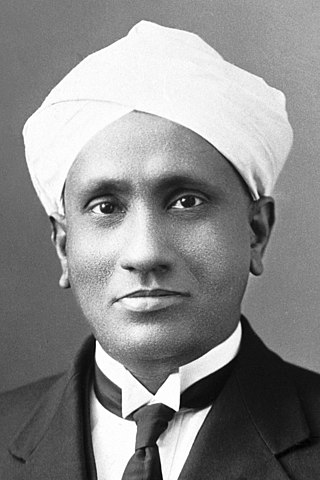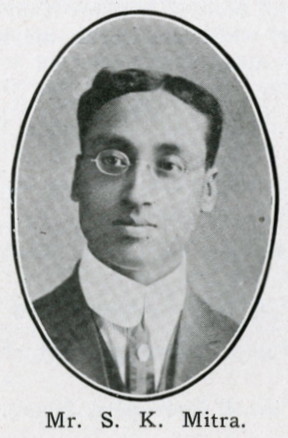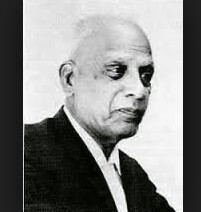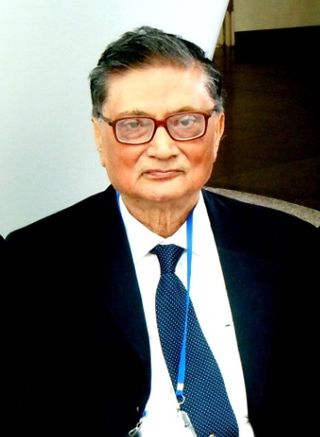Related Research Articles

A physicist is a scientist who specializes in the field of physics, which encompasses the interactions of matter and energy at all length and time scales in the physical universe. Physicists generally are interested in the root or ultimate causes of phenomena, and usually frame their understanding in mathematical terms. They work across a wide range of research fields, spanning all length scales: from sub-atomic and particle physics, through biological physics, to cosmological length scales encompassing the universe as a whole. The field generally includes two types of physicists: experimental physicists who specialize in the observation of natural phenomena and the development and analysis of experiments, and theoretical physicists who specialize in mathematical modeling of physical systems to rationalize, explain and predict natural phenomena.

Sir Chandrasekhara Venkata Raman was an Indian physicist known for his work in the field of light scattering. Using a spectrograph that he developed, he and his student K. S. Krishnan discovered that when light traverses a transparent material, the deflected light changes its wavelength and frequency. This phenomenon, a hitherto unknown type of scattering of light, which they called "modified scattering" was subsequently termed the Raman effect or Raman scattering. Raman received the 1930 Nobel Prize in Physics for the discovery and was the first Asian to receive a Nobel Prize in any branch of science.

Sisir Kumar Mitra MBE, FNI, FASB, FIAS, FRS was an Indian physicist.

Piara Singh Gill was an Indian nuclear physicist and a pioneer in cosmic ray nuclear physics. He was the first Director of Central Scientific Instruments Organisation (CSIO) of India. He was research fellow of University of Chicago (1940). He was research Professorship fellow of Tata Institute of Fundamental Research (TIFR) (1947), Officer-on-Special Duty (OSD) with the Atomic Energy Commission in New Delhi. Professor and head of the Department of Physics at Aligarh University (1949), Director of Central Scientific Instruments Organization (CSIO) (1959) and Professor Emeritus at Punjab Agricultural University (1971).

Sir Kariamanikkam Srinivasa Krishnan, was an Indian physicist. He was a co-discoverer of Raman scattering, for which his mentor C. V. Raman was awarded the 1930 Nobel Prize in Physics.

Sivaramakrishna Chandrasekhar FNA, FRS was an Indian physicist who won the Royal Medal in 1994. He was the founder-president of the International Liquid Crystal Society.

Kalpathi Ramakrishna Ramanathan was an Indian physicist and meteorologist. He was the first Director of Physical Research Laboratory, Ahmedabad. From 1954 to 1957, Ramanathan was President of the International Union of Geodesy and Geophysics (IUGG). Ramanathan was awarded Padma Bhushan in 1965 and Padma Vibhushan in 1976.

Indian Association for the Cultivation of Science (IACS) is a public, deemed, research university for higher education and research in basic sciences under the Department of Science & Technology, Government of India. Established in 29 July 1876 by Mahendralal Sarkar, a private medical practitioner, it focuses on fundamental research in basic sciences. It is Asia's oldest research institute located at Jadavpur, South Kolkata near Jadavpur University, Central Glass and Ceramic Research Institute and Indian Institute of Chemical Biology. It is spread over a limited area of 9.5 acres and currently in the process of building an advanced SMART campus at Baruipur.
Dipankar Das Sarma, popularly known as D.D. Sarma, is an Indian scientist and structural chemist, known for his researches in the fields of Solid State Chemistry, Spectroscopy, Condensed Matter Physics, Materials Science, and Nanoscience. He is a former MLS Chair Professor of Physics and Chairman of the Centre for Advanced Materials and the GAST Professor of Uppsala University, Sweden, A recipient of TWAS Physics Prize and the UNESCO Biennial Javed Husain Prize, Sarma was honored by the Council for Scientific and Industrial Research (CSIR), Government of India, in 1994, with the Shanti Swarup Bhatnagar Prize for Science and Technology.

Asok Kumar Barua was an Indian condensed matter physicist and the honorary Emeritus Professor of Indian Institute of Engineering Science and Technology, Shibpur, who focused on research in optics and optoelectronics. He was honoured by the Government of India in 2003 with Padma Shri, the fourth highest Indian civilian award.
Vishnu Ganesh Bhide (1925–2006) was an Indian physicist and educationist, known for his pioneering work on Mossbauer spectroscopy and his contributions to science education in India. He was the scientific advisor to the Government of India during 1973-75 and a member of the International Commission on the Applications of Mossbauer Effect. The Government of India awarded him the fourth highest civilian honour of the Padma Shri in 1992.
Barry Ramachandra Rao was an Indian space physicist and the vice chairman of the University Grants Commission of India. Known for his pioneering research in radio physics, Rao was a Member of Parliament of the Rajya Sabha and an elected fellow of all the three major Indian science academies viz. Indian Academy of Sciences, Indian National Science Academy and National Academy of Sciences, India. The Council of Scientific and Industrial Research, the apex agency of the Government of India for scientific research, awarded him the Shanti Swarup Bhatnagar Prize for Science and Technology, one of the highest Indian science awards for his contributions to Physical Sciences in 1965.

Chanchal Kumar Majumdar was an Indian condensed matter physicist and the founder director of S.N. Bose National Centre for Basic Sciences. Known for his research in quantum mechanics, Majumdar was an elected fellow of all the three major Indian science academies – the Indian National Science Academy, the National Academy of Sciences, India, and the Indian Academy of Sciences – as well a member of the New York Academy of Sciences and the American Physical Society.
Erode Subramanian Raja Gopal was an Indian condensed matter physicist, a former professor at the Indian Institute of Science and a former director of the National Physical Laboratory of India. Known for his research in condensed matter physics, Raja Gopal was an elected fellow of all the three major Indian science academies – the Indian National Science Academy, the National Academy of Sciences, India, and the Indian Academy of Sciences – as well as a member of the Institute of Physics. He was a former CSIR emeritus scientist, an alumnus of the University of Oxford and the author of three reference texts in condensed matter physics. The Council of Scientific and Industrial Research, the apex agency of the Government of India for scientific research, awarded him the Shanti Swarup Bhatnagar Prize for Science and Technology, one of the highest Indian science awards, for his contributions to Physical Sciences in 1978.
Narendra Kumar was an Indian theoretical physicist and a Homi Bhaba Distinguished Professor of the Department of Atomic Energy at Raman Research Institute. He was also an honorary professor at Jawaharlal Nehru Centre for Advanced Scientific Research.

Deepak Kumar was an Indian condensed matter physicist and a professor at the School of Physical Sciences of Jawaharlal Nehru University. Known for his research on quantum mechanics and other areas of condensed matter physics, Kumar was an elected fellow of the Indian Academy of Sciences. The Council of Scientific and Industrial Research, the apex agency of the Government of India for scientific research, awarded him the Shanti Swarup Bhatnagar Prize for Science and Technology, one of the highest Indian science awards, for his contributions to physical sciences in 1988.

Nelamangala Vedavyasachar Madhusudana is an Indian physicist and an emeritus scientist at Raman Research Institute. Known for his research on liquid crystals, Madhusudhana is an elected fellow of Indian Academy of Sciences and Indian National Science Academy. The Council of Scientific and Industrial Research, the apex agency of the Government of India for scientific research, awarded him the Shanti Swarup Bhatnagar Prize for Science and Technology, one of the highest Indian science awards, for his contributions to physical sciences in 1989.
Echur Varadadesikan Sampathkumaran is an Indian condensed matter physicist and a Distinguished Professor at the Tata Institute of Fundamental Research. Known for his research on the thermal and transport behaviour of magnetic systems, Sampathkumaran is an elected fellow of all the three major Indian science academies viz. Indian Academy of Sciences, Indian National Science Academy and National Academy of Sciences, India as well as The World Academy of Sciences. The Council of Scientific and Industrial Research, the apex agency of the Government of India for scientific research, awarded him the Shanti Swarup Bhatnagar Prize for Science and Technology, one of the highest Indian science awards, for his contributions to physical sciences in 1999.

Aditi Sen De is an Indian scientist, a professor in quantum information and computation group at the Harish-Chandra Research Institute, Allahabad. She is known for her research on quantum information and computation, quantum communication including quantum cryptography, quantum optics and many-body physics. The Council of Scientific and Industrial Research, the apex agency of the Government of India for scientific research, awarded her the Shanti Swarup Bhatnagar Prize for Science and Technology for her contributions to physical sciences in 2018. She is the first female physicist to be given this honour. In 2022, she was elected as a member of Indian Academy of Sciences and Indian National Science Academy.

The University College of Science, Technology and Agriculture are two of five main campuses of the University of Calcutta (CU). The college served as the cradle of Indian Sciences by winning the Nobel Prize in Physics in 1930 and many fellowships of the Royal Society London.
References
- 1 2 IACS. "Indian Physical Society Home Page". Indian Association for the Cultivation of Science. Retrieved 11 April 2021.
- ↑ Mahalanobis, P.C (1963). "Recent Developments in the Organization of Science in India". Sankhyā: The Indian Journal of Statistics, Series B. Indian Statistical Institute. 25 (1/2): 67–84. JSTOR 25051480.